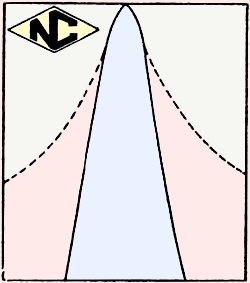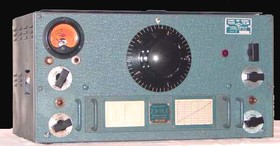|
May 1951 QST
 Table of Contents Table of Contents
Wax nostalgic about and learn from the history of early electronics. See articles
from
QST, published December 1915 - present (visit ARRL
for info). All copyrights hereby acknowledged.
|
National Company,
headquartered in Malden, Massachusetts, was a manufacturer of radio receivers for
military and amateur use in the mid part of last century. They ran many full-page
advertisements that were actually infomercials in that much more of the content
presented generally useful technical information than pitched a product. This particular
installment, which appeared in a 1951 issue of QST magazine, describes how extensive
experimentation and testing on their HRO-50 receiver by a Ham radio guy led to a
circuit change in future production models. It involved adding a tuning stage to
the band select filter. An equivalent scenario today would probably involve an algorithm
change to the SDR (software-defined radio) software.
National Company Advertisement
Number two hundred-five of a series
 Many old-timers will remember an expression
that was used way back in the roaring twenties. I may be wrong, but I believe it
was first used with regard to the fellows who felt that the way to reduce the ripple
of a power supply was to pile on all the chokes and capacitors that one could get
his hands on. If you hung on enough chokes and capacitors, the ripple was sure to
be reduced sufficiently. This system was called "brute force and stupidity." Of
course, there were (and still are) other applications. A few years ago, I endangered
my well-being by applying this expression to a somewhat unstable modulated-oscillator
being used on two meters with an input of over 900 watts. Many old-timers will remember an expression
that was used way back in the roaring twenties. I may be wrong, but I believe it
was first used with regard to the fellows who felt that the way to reduce the ripple
of a power supply was to pile on all the chokes and capacitors that one could get
his hands on. If you hung on enough chokes and capacitors, the ripple was sure to
be reduced sufficiently. This system was called "brute force and stupidity." Of
course, there were (and still are) other applications. A few years ago, I endangered
my well-being by applying this expression to a somewhat unstable modulated-oscillator
being used on two meters with an input of over 900 watts.
The "brute force" system does work and there are applications where it may be
the most effective way if the "stupidity" is replaced with "know-how". Such an application
of "brute force and know-how" has resulted in improved selectivity in the HRO-50
receiver.
Sharper selectivity could be obtained by lowering the frequency of the intermediate
frequency amplifier. This method would have two drawbacks. One is the poorer image
ratio that would result. The other is the fact that this would narrow the selectivity
curve all over. The "nose" would be narrowed in the same proportion as the "skirts".
The nose of the present HRO-50 is now about four kc. wide. W1JEL has made rather
extensive tests that show that this is about the minimum width that can be used
for conventional double-side band reception without loss of readability. More on
this in a later page.
It is much better to keep the intermediate frequency as high as possible without
hiatus (look it up, I had to) in the tuning range of the receiver. By keeping the
intermediate frequency at 455 kc., we do not affect the image ratio. How can we
get better selectivity without narrowing the nose?
 Examining selectivity curves of double-tuned
circuits, particularly those using critical coupling, it will be noted that the
nose is relatively flat while the skirts are steep. If we add more transformers
to the circuit, very little change will be effected in the nose but the skirts will
be pulled in considerably. Raising the Q of the transformers will not have nearly
as much effect and this effect is apt to be reduced under conditions of high humidity.
Pulling in the skirts produces a very definite and worthwhile reduction in splatter
and heterodyne interference from signals very close to the desired one while not
reducing the readability of the wanted signal. Examining selectivity curves of double-tuned
circuits, particularly those using critical coupling, it will be noted that the
nose is relatively flat while the skirts are steep. If we add more transformers
to the circuit, very little change will be effected in the nose but the skirts will
be pulled in considerably. Raising the Q of the transformers will not have nearly
as much effect and this effect is apt to be reduced under conditions of high humidity.
Pulling in the skirts produces a very definite and worthwhile reduction in splatter
and heterodyne interference from signals very close to the desired one while not
reducing the readability of the wanted signal.
Following this idea, the intermediate frequency amplifier of the HRO-50 has been
changed by increasing the number of stages from two to three and the number of IF
transformers from two to six (not including the crystal filter). More than six transformers
would not be economically worth while as this procedure follows the law of diminishing
returns. This change reduces the skirt selectivity from about twenty-four to about
eleven kc. at 60 db down while the nose is still about four kc.
In line with our policy of making any minor changes in the HRO as soon as practicable
when it is found that improvements are possible, this change is being made in the
HRO-50 immediately. The new model will be called the HRO-50-1 and will be available
shortly.
Cal Hadlock, W1CTW
Here are all the National Company advertisements I have:
- National's Company:
Merry Christmas and Happy New Year, January 1941
- National Company:
Noise Limiters, September 1950
- National Company: Modulators, April
1942
- National Company: Switches,
May 1939
- National Company: TMS Condenser, March 1939
- National Company: TVI, October
1953
- National Company:
Amateur Radio Activity, December 1952
- National Company: HRO-50
Receiver, May 1951
- National Company:
Noise Limiters, September 1950
- National
Company: Modulation, October 1947
- National Company:
Merry Christmas and Happy New Year, January 1942
- National Company:
Merry Christmas and Happy New Year, January 1941
- National Company: Switches,
May 1939
- National Company: AC Power Strip,
April 1939
- National Company: TMS Condenser,
March 1939
- National Company Catalog: NC80X
/ NC81X Receiver Advertisement, September 1937
- National Company:
IF Circuits, September 1935
Posted May 6, 2022
(updated from original post on 8/18/2016)
|








 Many old-timers will remember an expression
that was used way back in the roaring twenties. I may be wrong, but I believe it
was first used with regard to the fellows who felt that the way to reduce the ripple
of a power supply was to pile on all the chokes and capacitors that one could get
his hands on. If you hung on enough chokes and capacitors, the ripple was sure to
be reduced sufficiently. This system was called "brute force and stupidity." Of
course, there were (and still are) other applications. A few years ago, I endangered
my well-being by applying this expression to a somewhat unstable modulated-oscillator
being used on two meters with an input of over 900 watts.
Many old-timers will remember an expression
that was used way back in the roaring twenties. I may be wrong, but I believe it
was first used with regard to the fellows who felt that the way to reduce the ripple
of a power supply was to pile on all the chokes and capacitors that one could get
his hands on. If you hung on enough chokes and capacitors, the ripple was sure to
be reduced sufficiently. This system was called "brute force and stupidity." Of
course, there were (and still are) other applications. A few years ago, I endangered
my well-being by applying this expression to a somewhat unstable modulated-oscillator
being used on two meters with an input of over 900 watts. 
